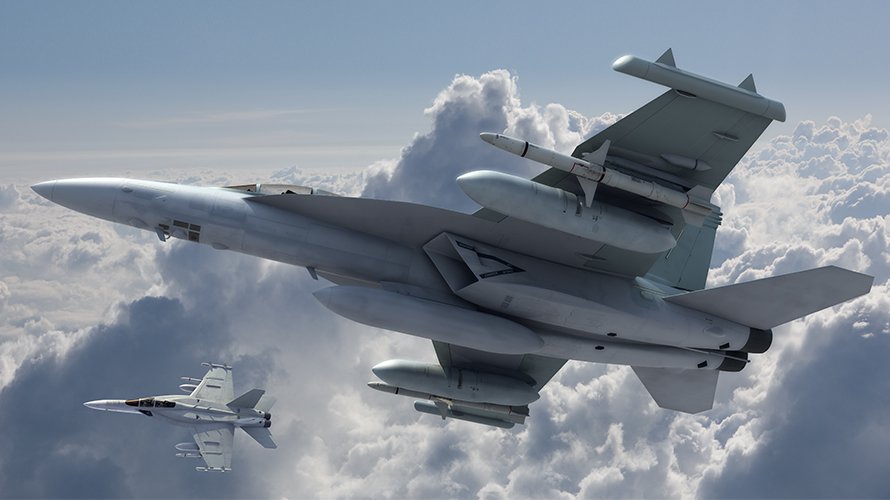
The Government Accountability Office has denied a protest by Raytheon over a contract award for the Navy’s Next Generation Jammer, according to a posting on the GAO website.
With the protest concluded, Naval Air Systems Command has now awarded contracts to L3 and Northrop Grumman to study the low-band portion of the Navy’s three-part strategy to replace the legacy ALQ-99 system found on the Navy’s fleet of EA-18G Growler electronic attack aircraft. L3 was awarded $35.7 million and Northrop was awarded $35.2 million for the low band effort.
NAVAIR has split the replacement for the ALQ-99 into three segments: low, mid and high bands. Instead of competing for the low-band work directly, NAVAIR put out a 2017 solicitation for “[a] demonstration that will lead to an assessment of the maturity level of the technologies that might be applied to a low band jammer pod,” a NAVAIR spokesperson told USNI News in a statement in August. “This will help inform the appropriate acquisition strategy of the program.”
An L3 spokeswoman declined to comment on the competition when contacted by USNI News.
“Northrop Grumman will deliver a mature, low-risk and exceedingly capable solution for Next Generation Jammer Low Band that outpaces evolving threats and enables the Navy’s speed-to-fleet path,” said Thomas Jones, vice president and general manager, airborne C4ISR systems, Northrop Grumman.
“Our NGJ-LB pod provides multi-mission capability for electromagnetic maneuver warfare. We stand ready to demonstrate advancements in this mission area and deliver ahead of schedule.”
The new study contracts for follows an initial 2013 $271 million award to Raytheon for the ALQ-249, the mid-band portion of the NGJ. In 2016, Raytheon was awarded a subsequent $1.2 billion for the effort.
In a statement to USNI News, a Raytheon spokeswoman said, “we accept the GAO’s decision and look forward to continuing to support the Navy’s Airborne Electronic Attack mission.”
The gradual introduction of the NGJ systems onto U.S. and Australian Boeing EA-18G Growlers will initially augment the ALQ-99 before eventually replacing the legacy capability, according to NAVAIR.
Breaking Defense defense reported Capt. Michael Orr said early iterations of the system would begin aerial testing next year and the entire system was set to reach an initial operational capability sometime in 2022.
The following are the Pentagon Oct. 25, 2018 contract announcements for the low-band jammer study contracts.
L3 Technologies Inc., Salt Lake City, Utah, is awarded a $35,757,711 cost-plus-fixed-fee contract to provide for the demonstration and test of existing technologies and associated technical data that may potentially provide a solution for an airborne wideband low radio frequency band jamming application in support of the Next Generation Jammer Low Band (Increment 2) program. Work will be performed in Salt Lake City, Utah (57 percent); Boulder, Colorado (16 percent); Carlsbad, California (9 percent); Stuart, Florida (5 percent); Waco, Texas (1 percent); Reston, Virginia (1 percent); Guthrie, Oklahoma (1 percent); Stow, Massachusetts (1 percent); St. Louis, Missouri (1 percent); and in Europe (4 percent), and is expected to be completed in June 2020. Fiscal 2018 research, development, test and evaluation (Navy) funds in the amount of $14,704,000 will be obligated at time of award, all of which will expire at the end of the current fiscal year. This contract was competitively procured via a broad agency announcement; four offers were received. The Naval Air Systems Command, Patuxent River, Maryland, is the contracting activity (N00019-19-C-0014).
Northrop Grumman Systems Corp., Bethpage, New York, is awarded a $35,180,752 cost-plus-fixed-fee contract to provide for the demonstration and test of existing technologies and associated technical data that may potentially provide a solution for an airborne wideband low radio frequency band jamming application in support of the Next Generation Jammer Low Band (Increment 2) program. Work will be performed in Linthicum, Maryland (42 percent); Bethpage, New York (38 percent); North Amityville, New York (8 percent); Melville, New York (8 percent); Rolling Meadows, Illinois (1 percent); Hollywood, Maryland (1 percent); Melbourne, Florida (1 percent); and Redondo Beach, California (1 percent), and is expected to be completed in June 2020. Fiscal 2018 research, development, test and evaluation (Navy) funds in the amount of $14,704,000 will be obligated at time of award, all of which will expire at the end of the current fiscal year. This contract was competitively procured via a broad agency announcement; four offers were received. The Naval Air Systems Command, Patuxent River, Maryland, is the contracting activity (N00019-19-C-0015).





